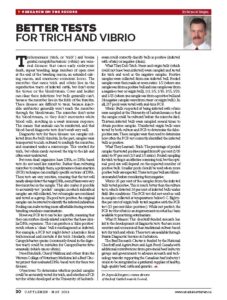Better Tests for Trich and Vibrio
This article written by Dr. Reynold Bergen, BCRC Science Director, originally appeared in the May 2014 issue of Canadian Cattlemen magazine and is reprinted on the BCRC Blog with permission of the publisher.
Trichomoniasis (trich, or “trick”) and bovine genital campylobacteriosis (vibrio) are venereal diseases that cause early embryonic death, repeat breeding, large numbers of open cows at the end of the breeding season, an extended calving season, and enormous economic losses. The microbes that cause trich and vibrio live in the reproductive tracts of infected cattle, but don’t enter the tissues or the bloodstream. Cows and heifers can clear these infections but bulls generally can’t, because the microbes live in the folds of the foreskin. These diseases are difficult to treat, because injectable antibiotics generally won’t reach the microbes through the bloodstream. The microbes don’t enter the bloodstream, so they don’t encounter white blood cells, resulting in a weak immune response. This means that animals can be re-infected, and that blood-based diagnostic tests don’t work very well.
Diagnostic tests for these diseases use samples collected from the bull’s foreskin. In the past, samples were transported to a lab, cultured to multiply the microbes, and examined under a microscope. This worked for trich, but vibrio rarely survived the trip to the lab and often went undetected.
But even dead organisms have DNA, so DNA-based tests do not need live microbes. Rather than culturing microbes to multiply them, a polymerase chain reaction (PCR) technique can multiply specific sections of DNA. These tests are very sensitive, meaning that the test will nearly always detect the target DNA, even if there were very few microbes in the sample. This also makes it possible to accurately test “pooled” samples, in which individual samples are still collected, but sub-samples are combined and tested as a group. If a pool tests positive, the original samples can be re-tested to identify the infected individual. Pooling can make testing more affordable during routine breeding soundness examinations.
However, PCR tests can be less specific, meaning that they can confuse closely-related microbes that have similar DNA sequences. This can produce a ‘false positive’ result, where a ‘clean’ bull is mis-diagnosed as infected. For example, a PCR test might detect a harmless fecal trichomonad and mistake it for trich. Similarly, other Campylobacter species (commonly found in the digestive tract) could be mistaken for Campyolbacter fetus venerealis (which causes vibrio).
Steve Hendrick, Cheryl Waldner, and others from the Western College of Veterinary Medicine led a Beef Cluster project that evaluated DNA-based tests for these two diseases.
Objectives
To determine whether pooled samples could be accurately tested for trich, and whether a PCR test for vibrio developed at the University of Saskatchewan could correctly classify bulls as positive (infected with vibrio) or negative (clean).
What They Did
Trich: Steers and virgin bulls (which could not have been infected) were sampled and tested for trich and used as the negative samples. Positive samples were collected from one infected bull. Pooled samples were then made at seven ratios: 1/2 (where 1 sample was from a positive bull and 1 sample was from a negative steer or virgin bull), 1/3, 1/5, 1/10, 1/15, 1/20, and 1/25 (where 1 sample was from a positive bull and 24 negative samples were from steers or virgin bulls). In all, 217 pools were tested with real-time PCR.
Vibrio: Bulls suspected of being infected with vibrio were sampled at the University of Saskatchewan so that the sample could be cultured before the microbe died. Thirteen infected bulls were sampled several times to obtain positive samples. Uninfected virgin bulls were tested by both culture and PCR to determine the false-positive rate. These samples were then used to determine how often the PCR test correctly identified the infected bulls as positive.
What They Learned
Trich: The percentage of pooled samples that tested positive ranged from 90% (1/10 ratio) to 97% (1/3 and 1/5 ratios). Pooled sampling for trich testing is an effective screening tool, but the optimal pool size will depend on the expected number of positive bulls. Smaller pools should be used when more positive bulls are expected. Three tests per bull are still recommended before considering them negative.
Vibrio: 85% of the samples from the infected bulls tested positive. This is much better than the culture tests, which detected 38% of infected bulls under field-like conditions. The PCR test did not work as well in samples collected at temperatures below 5oC. 85% of virgin bulls tested negative with the PCR test (15% false-positives). While not perfect, the PCR test for vibrio is an improvement on what has been available to practicing veterinarians.
What it Means
This check-off funded research has led to the development of diagnostic tests that are more sensitive and economical than traditional culture-based tests for trich and vibrio. These tests are available through Prairie Diagnostic Services in Saskatoon.
Learn more
Reproductive Failure
BeefResearch.ca
Click here to subscribe to the BCRC Blog and receive email notifications when new content is posted.
The sharing or reprinting of BCRC Blog articles is typically welcome and encouraged, however this article requires permission of the original publisher.
We welcome your questions, comments and suggestions. Contact us directly or generate public discussion by posting your thoughts below.
